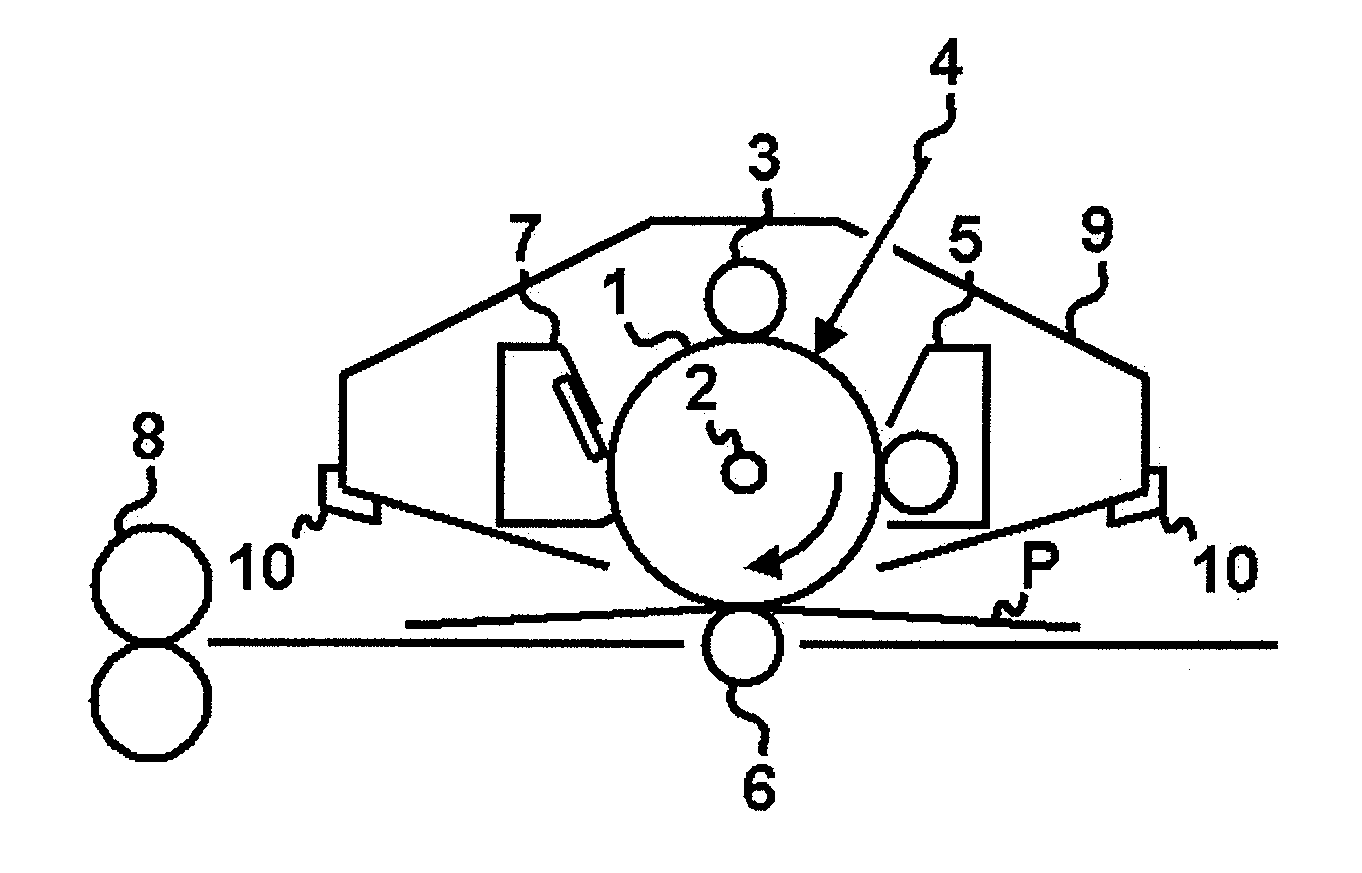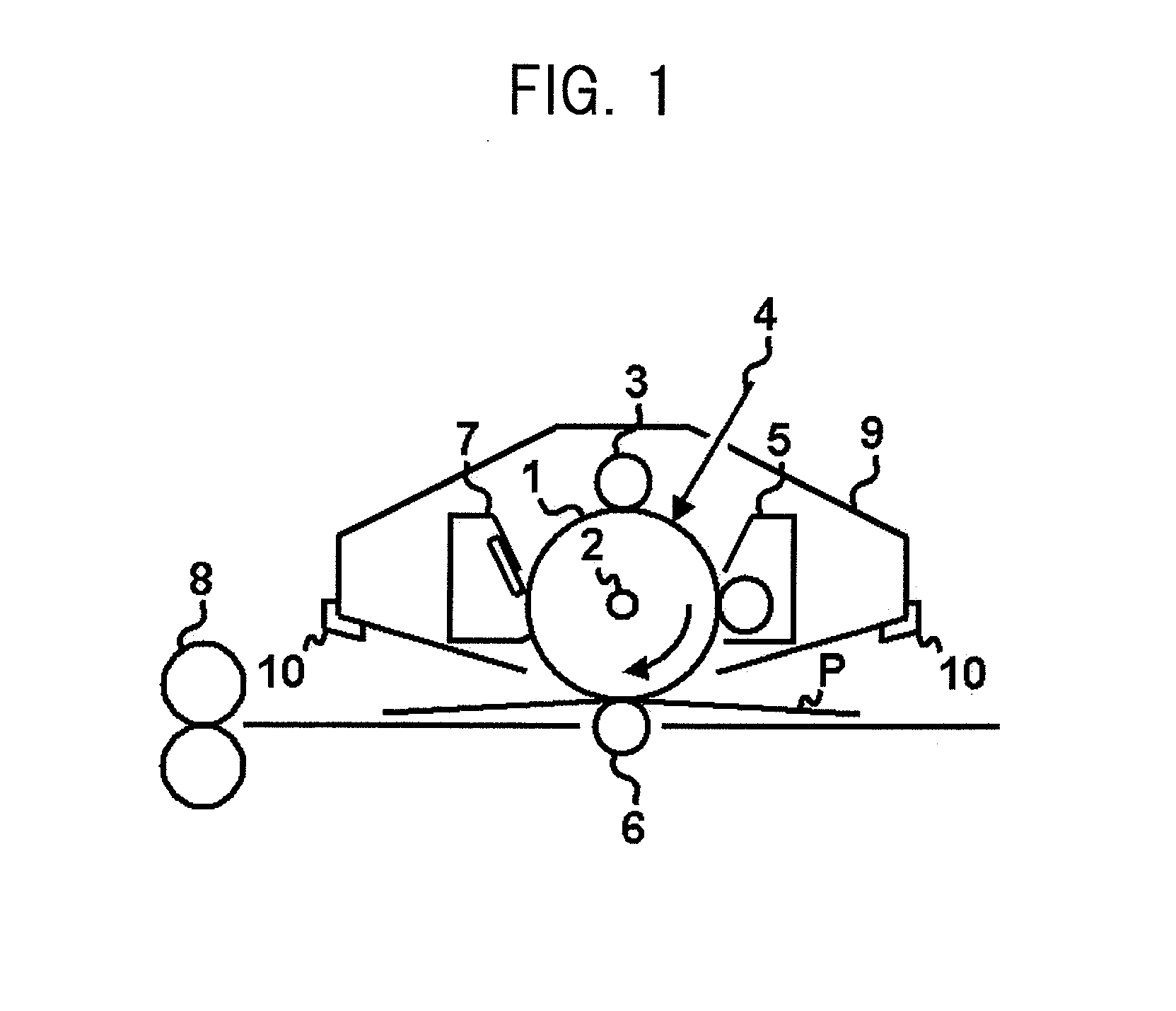Electrophotographic photosensitive member, process cartridge and electrophotographic apparatus
- Summary
- Abstract
- Description
- Claims
- Application Information
AI Technical Summary
Benefits of technology
Problems solved by technology
Method used
Image
Examples
synthesis example 1
Synthesis of Polyester Resin A (A1) Having Repeating Structural Units Represented by the Above Formulas (1-6), (1-12), (2-12) and (2-24)
[0127]Dicarboxylic acid halide (24.6 g) represented by the following formula (6-1):
and dicarboxylic acid halide (24.6 g) represented by the following formula (6-2):
were dissolved in dichloromethane to prepare an acid halide solution.
[0128]Furthermore, separately from the acid halide solution, a diol (21.7 g) having a siloxane structure represented by the following formula (7-1):
and a diol (43.9 g) represented by the following formula (8-1):
were dissolved in a 10% aqueous sodium hydroxide solution. Furthermore, tributylbenzyl ammonium chloride was added as a polymerization catalyst and stirred to prepare a diol compound solution.
[0129]Next, the above acid halide solution was added to the above diol compound solution while stirring to initiate polymerization. The polymerization was performed for 3 hours with stirring while the reaction temperature was...
synthesis examples 2 to 7
Synthesis of Polyester Resins A (A2 to A7) Having Repeating Structural Units Represented by the Above Formulas (1-6), (1-12), (2-12) and (2-24)
[0132]Use amounts of dicarboxylic acid halides (6-1) and (6-2) and the diol compounds (7-1) and (8-1) used in Synthesis Example 1 in synthesizing were controlled to synthesize polyester resins A (A2 to A7) shown in Table 1.
[0133]Furthermore, the contents of the siloxane moieties in polyester resins A (A2 to A7) were calculated in the same manner as in Synthesis Example 1 and shown in Table 1.
[0134]Furthermore, the weight average molecular weights of the polyester resins A (A2 to A7) were measured in the same manner as in Synthesis Example 1. The weight average molecular weights were respectively:
polyester resin A (A2): 120,000
polyester resin A (A3): 100,000
polyester resin A (A4): 80,000
polyester resin A (A5): 130,000
polyester resin A (A6): 150,000
polyester resin A (A7): 160,000.
synthesis example 8
Synthesis of Polyester Resin A (B1) Having Repeating Structural Units Represented by the Above Formulas (1-7), (1-13), (2-12) and (2-24)
[0135]Dicarboxylic acid halide (24.4 g) represented by the above formula (6-1) and dicarboxylic acid halide (24.4 g) represented by the above formula (6-2) were dissolved in dichloromethane to prepare an acid halide solution.
[0136]Furthermore, separately from the acid halide solution, using diol (21.0 g) having the siloxane structure represented by the following formula (7-2):
and diol (44.2 g) represented by the above formula (8-1), the same operation as in Synthesis Example 1 was performed to obtain polyester resin A (B1) (70 g) having repeating structural units represented by, the above formulas (1-7), (1-13), (2-12) and (2-24). This is shown in Table 1.
[0137]Furthermore, the content of the siloxane moiety of polyester resin A (B1) was calculated in the same manner as in Synthesis Example 1 and shown in Table 1.
[0138]Furthermore, the weight averag...
PUM
| Property | Measurement | Unit |
|---|---|---|
| Percent by mass | aaaaa | aaaaa |
| Percent by mass | aaaaa | aaaaa |
| Percent by mass | aaaaa | aaaaa |
Abstract
Description
Claims
Application Information
 Login to View More
Login to View More - R&D
- Intellectual Property
- Life Sciences
- Materials
- Tech Scout
- Unparalleled Data Quality
- Higher Quality Content
- 60% Fewer Hallucinations
Browse by: Latest US Patents, China's latest patents, Technical Efficacy Thesaurus, Application Domain, Technology Topic, Popular Technical Reports.
© 2025 PatSnap. All rights reserved.Legal|Privacy policy|Modern Slavery Act Transparency Statement|Sitemap|About US| Contact US: help@patsnap.com



